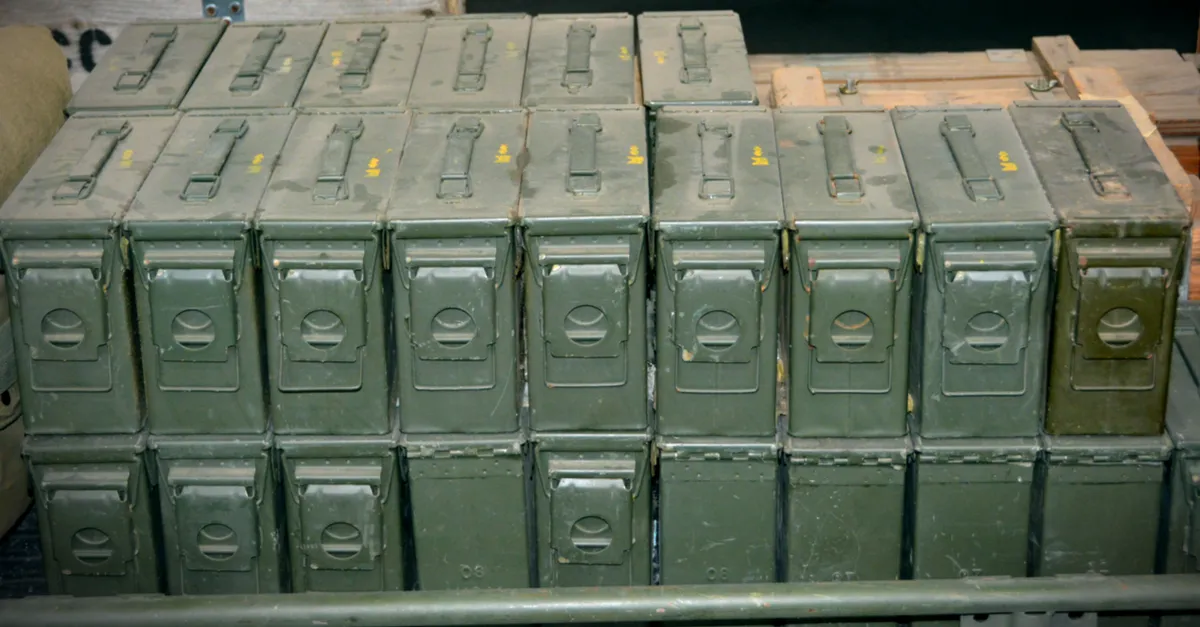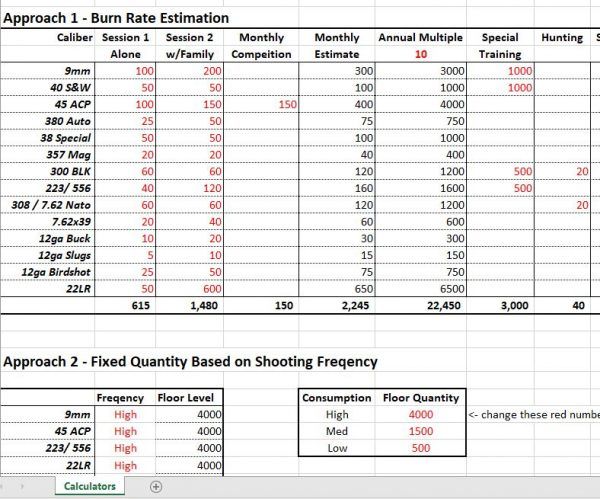How Much Ammunition Should You Stockpile?

While there are rules of thumb and estimates you can use, it is up to you to take the time to determine your future needs and include a buffer for what we’ll just call “uncommon events”. But how much is that? In this article, I’ll throw some strategies out there and if they are helpful then cool, if not, oh well they are free so you’ll certainly get your money’s worth.
I’m going to cut to the chase here and tell you right off the bat that there is no single correct answer to the question of how much ammo should have stockpiled. It’s like trying to answer the question of how much food or water you should have stored for daily and emergency use. Folks have batted these questions around since before there was an internet and there is no consensus.
I’ll start off by dropping the food and water question – you’ll need to research that one separately I’m an ammo guy, so food and water are best left to a food and water guy (or gal).
So how much ammo should you have on hand at any given point in time?
I have two approaches for you to consider: a burn rate estimate; and a fixed “floor” approach.
Approach 1: Estimate your ammo usage “Burn Rate”:
Let’s start off with an estimate of how much ammunition you “consume” in a given time period then you can decide how many periods of typical use you want to plan for…
So, first, start by thinking about your typical outing to the range. What guns do you shoot regularly? What do you shoot occasionally? Are you working toward proficiency in any particular platform (AR15 or pump shotgun, for example)?
If you only have 1 or 2 guns then this is easy. If you are like me and have a dozen or more, then the calculation gets a little more complicated. You will probably shoot much more of some rounds and less of others. For now let’s just focus on rounds you should in a typical month and exclude the special rounds – hunting rounds, self-defense rounds, and anything you would use for special courses or training – we’ll add these back in the end.
What I did was think about the guns I shoot on a typical outing even though I won’t bring every gun every time. I figured IF I brought a particular gun, what would my normal round count be? I tried to include a consumption number for every caliber even if there are guns I don’t train with regularly but will pick up once in a while (like our Ruger LCP in 380 ACP – I threw in half a box (25 rounds) there for example).
For my family of 5 with a wife and three daughters who shoot occasionally, I created two “outings”: One for by myself and one for when the family joins me. The family or at least Danielle, my wife, join me about every other outing.
Now you could come up with an annual number from here, or you could instead think about a typical month. I went with the monthly route in my calculations but made some adjustments when I translated it to an annual number which you’ll see here shortly. I’ve included a handy dandy ammunition stockpile calculator so you can follow along and put in your own numbers.

Download the Ammunition Stockpile Calculator
So for monthly, I figured I get out to shoot about twice per month (about every other week) I would LOVE to increase that to weekly but you know: chores, home projects, and uh… sleeping sometimes take priority. So for my calculations, I figured out what my consumption is when I go out alone and then when I bring the family.
I also like to shoot in one competition each month so I will include that in my monthly number.
So now you should have an estimate for your monthly ammunition “burn rate” – a term we can borrow from startup company jargon and use for our own purposes here.
Now think about your annual shooting sessions. Do you get out in the heat of summer and the cold of winter like a machine, or do you skip some times as I do? Figure out what a realistic annual multiplier would be and simply multiply by that to get to an annual number. I chose 10 for my multiplier instead of 12 because I know there are months in the winter we don’t get out, or where I’ll do one session instead of two. If you shoot at an indoor range, the weather might not be a factor but time and money might affect your number here.
Now that you have a base annual number let’s get back to those special situations: hunting, self-defense, and special courses. If you are like most hunters you will take the time to zero your rifle using as few of your actual hunting rounds as possible, then you’ll hunt and shoot one to five rounds. In my (limited) hunting experience I would estimate a box of 20 rounds per rifle per season per caliber – but you would know your own consumption.
Do the same with your self-defense ammo need and take into account that most people should shoot their carry ammo and refresh it at least every 3 to 6 months.
If you plan on taking any courses in the upcoming year then add those here as well. Those are outside of your normal outings but may replace an outing.
Add all of this together for a very rough estimate of your annual ammunition needs.
Okay! So now you should have some form of an annual number after going through the above. Remember this is just normal consumption and doesn’t take into account any sort of ammo shortage, alien attack, or killer virus.
I went through the above exercise across all of the calibers we currently shoot and ended up with about 26k rounds – or about 20k after removing 22LR. That is a lot and probably a very generous estimate of what we actually shoot. Looking at the ending annual numbers in terms of cases of ammo I feel like they would provide a good buffer if we were to target these for our family stockpile.
So let’s look at a second simpler approach…
Approach 2: Fixed Quantity Based on Shooting Frequency
The idea here is that you want a pre-determined quantity-based “floor” for each caliber you shoot and will replenish what you shoot so you have that much in your supply at all times.
Start by grouping your calibers by frequency of how often you shoot: high, medium, and low.
High-frequency calibers are those you will take out just about every time you go shooting. These are the guns you want to be most proficient in. I would put 9mm and 45 ACP in this category from my pistol calibers and .223/556 for my rifle calibers. I would include 22LR in this group as well.
For “medium” frequency calibers I would include anything that we take out once a month and spend a shooting session with for fun or proficiency. For my family, this would include 300 BLK, 40 S&W, 38 Special, 12ga buck, 12 ga bird, and 308/7.62 Nato. These are based on the guns I own and the types of shooting I do.
For my “low” frequency calibers I would throw in all the rest. In my case, I might include 357 Magnum, 380 Auto, 12ga Slugs, 308 Hunting, and surprisingly 7.62×39 (I have a Mini-30 but don’t shoot it very much – maybe this will change once I get my hands on an AK variant I’ve been eyeing.) This last one brings up a good point, while 7.62×39 is something I don’t shoot often now, I might move it up a level or two if I plan to buy something that I will shoot often (like an AK that I want to become more proficient in).
Now that you have calibers grouped into high, medium, and low calibers – assign an arbitrary “stockpile” quantity that you would feel comfortable with for each caliber. You should take into account the type of rounds (i.e., 22LR will have a higher quantity than other rounds). This can be based on a realistic consumption and budget level.
For me, that might look like 4000 rounds for all of my high-frequency rounds, 1000-1500 for my medium frequency rounds, and 500 to 700 for my low-frequency rounds. For 22LR I would increase that to maybe 5000 or 6000 rounds based on past experience.
These now become your stockpile goals. My first pass came out to about 26k which I was surprised to see matched my Approach 1 pretty well!
Summary
You are the master of your ammo stockpile so play around with the numbers until you feel you have something that makes sense for you and your family based on factors like budget, plans to buy or sell guns, future hunting trips, or training courses, etc.
The point here is that you have some sort of a starting point so you can start accumulating your ammo supply over time as budget permits.
Now, once you have your ammo quantity “floor” numbers and you shoot up a certain caliber (take a class for example) then you should get that caliber back up to your goal before spending money on a new gun or accessories.
As a typical gun owner, I like buying guns more than I like buying ammunition. The funny thing to say since I run an ammo company, but I’ll be the first to admit that it is true. I spend a lot of my free time researching the latest gun and planning my next purchase! (I did mention an AK didn’t I?)
Once you have a plan, it helps you with discipline so you’ll know what to spend money on next.
Like I started off this article by saying, there is no perfect formula for how much ammo you should have. Your situation, budget, space, and time will dictate. The real takeaway is that you should give it some thought and come up with some kind of a plan of action then put that plan into place so you aren’t caught with your pants down if all hell breaks loose in the future from zombies, aliens, or gun-grabbing Democrats!
